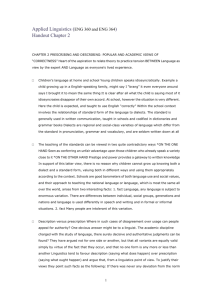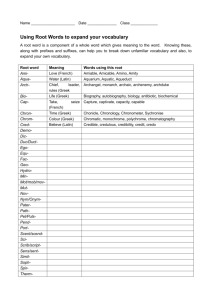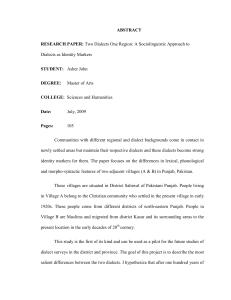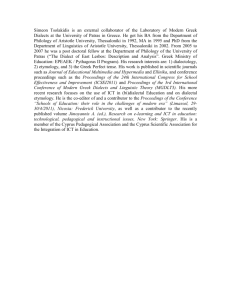Greek Dialects: Archaic & Classical Ages
advertisement
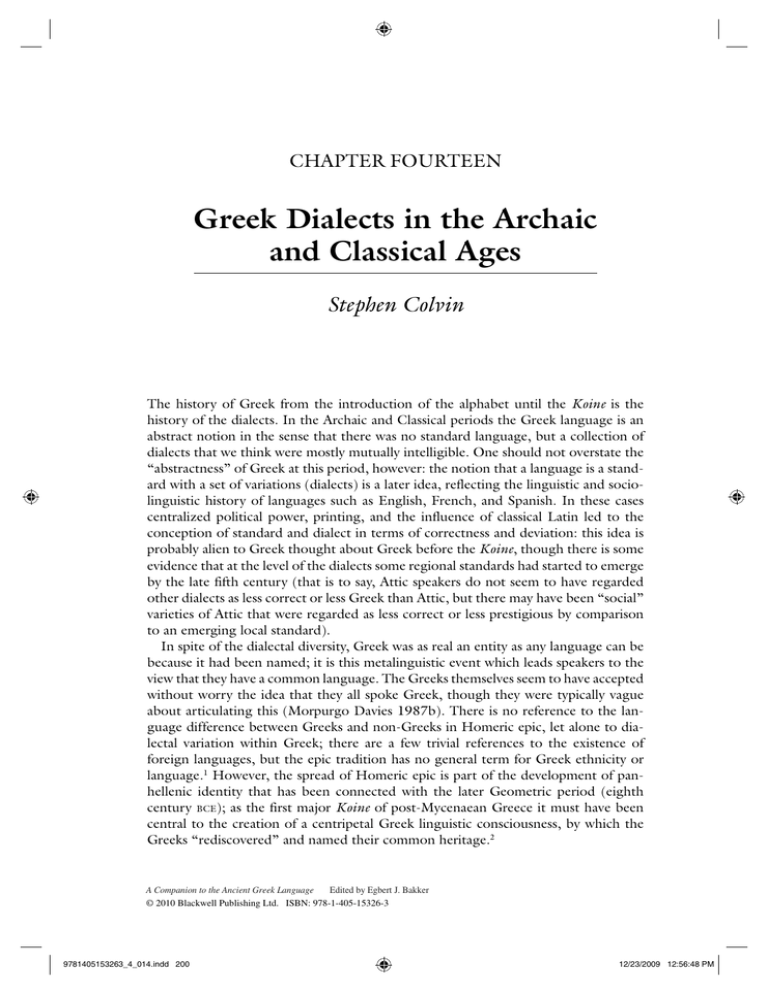
CHAPTER FOURTEEN Greek Dialects in the Archaic and Classical Ages Stephen Colvin The history of Greek from the introduction of the alphabet until the Koine is the history of the dialects. In the Archaic and Classical periods the Greek language is an abstract notion in the sense that there was no standard language, but a collection of dialects that we think were mostly mutually intelligible. One should not overstate the “abstractness” of Greek at this period, however: the notion that a language is a standard with a set of variations (dialects) is a later idea, reflecting the linguistic and sociolinguistic history of languages such as English, French, and Spanish. In these cases centralized political power, printing, and the influence of classical Latin led to the conception of standard and dialect in terms of correctness and deviation: this idea is probably alien to Greek thought about Greek before the Koine, though there is some evidence that at the level of the dialects some regional standards had started to emerge by the late fifth century (that is to say, Attic speakers do not seem to have regarded other dialects as less correct or less Greek than Attic, but there may have been “social” varieties of Attic that were regarded as less correct or less prestigious by comparison to an emerging local standard). In spite of the dialectal diversity, Greek was as real an entity as any language can be because it had been named; it is this metalinguistic event which leads speakers to the view that they have a common language. The Greeks themselves seem to have accepted without worry the idea that they all spoke Greek, though they were typically vague about articulating this (Morpurgo Davies 1987b). There is no reference to the language difference between Greeks and non-Greeks in Homeric epic, let alone to dialectal variation within Greek; there are a few trivial references to the existence of foreign languages, but the epic tradition has no general term for Greek ethnicity or language.1 However, the spread of Homeric epic is part of the development of panhellenic identity that has been connected with the later Geometric period (eighth century BCE); as the first major Koine of post-Mycenaean Greece it must have been central to the creation of a centripetal Greek linguistic consciousness, by which the Greeks “rediscovered” and named their common heritage.2 A Companion to the Ancient Greek Language Edited by Egbert J. Bakker © 2010 Blackwell Publishing Ltd. ISBN: 978-1-405-15326-3 9781405153263_4_014.indd 200 12/23/2009 12:56:48 PM Greek Dialects 201 Greek willingness to accept the dialects as valid representatives of Greek suggests that they conceived the relationship of dialect to language as one of concrete species (τὸ εἶδος) to an abstract genus (τὸ γένος), “Greek” (the Greek terminology is Aristotelian, though not applied by Aristotle to language). Given the generally low level of anxiety about dialect difference, there is every reason to suppose that in inter-state contact the Greeks would have engaged in dialect accommodation: when the cost is lower than the anticipated reward, speakers of different varieties will converge in interaction (the cost here being the speaker’s own sense of identity and integrity). Since the Greeks seem not have suffered from a high degree of linguistic insecurity, linguistic politics did not play a large role in their culture until the Hellenistic period, when the written standard was fossilized and they began to look back to an earlier period of purity and authenticity. The term for speaking Greek was rendered with the verb ἑλληνίζω (with the optional specification of a word for language, such as τῇ φωνῇ), or with the adjective “Greek” (ἑλληνικός, ἑλληνίς) applied to a noun for speech, such as γλῶσσα. It is difficult, unfortunately, to be clear from the written sources how the Greeks designated dialectal difference at this period. The various Greek words for “language” were routinely used to refer to the dialects also; the unambiguous use of the term ἡ διάλεκτος “dialect” is hard to pin down before the Hellenistic period. The term derives from the verb διαλέγομαι, in which in the Classical period the pre-verb δια- mostly has the force of “through, across,” hence “I converse, talk (with).” There are, however, indications that by the fifth century the verb could perform a different function, one in which the pre-verb had its other possible implication, “in different directions” – hence “I talk separately, in a different way.” Herodotus (1.142) uses the verb twice in describing the dialects of Ionia, and a fragment of Aristophanes (706 PCG) shows that the derived noun διάλεκτος could also mean “idiom, peculiar way of speaking”: the word refers here to a social dialect, belonging to a character who speaks “the normal dialect of the city [διάλεκτον . . . μέσην πόλεως], not the fancy high-society accent, nor uneducated, rustic talk.” It is probable, therefore, that the word could also be used to denote a characteristic regional idiom, though the context would have to make it clear that the salient differential was region. Our picture of the Greek dialects is incomplete, in two ways. First, many regions of Greece took up writing late, in the period when the dialects were retreating in the face of the Koine, which gradually took over as the written standard. Even before the appearance of the Hellenistic Koine (based on Attic-Ionic, see ch. 16), in many culturally backward areas in the northern and western areas of mainland Greece one has the impression that the dialect presented in inscriptions is a local written Koine (in fact, a West Greek koinā) rather than a close approximation to a regional idiom. Secondly, even in those regions where inscriptions (or literary texts) go back to an early period, it is likely that we are dealing with a standardized or official version of the dialect, which – in the nature of written languages – reflected a conservative variety of the dialect and was largely immune to change (since writing systems quickly become fossilized). There are some exceptions to this, notably in Boeotia, where efforts were made to keep the spelling abreast of rapid phonological changes. Language is so mixed up with politics and collective identity that it is difficult to predict in a given case what the factors influencing the choice of an “official” language variety will be: candidates are likely to include distinctiveness (from neighbors), reference to prestigious literary/ 9781405153263_4_014.indd 201 12/23/2009 12:56:48 PM 202 Stephen Colvin poetic traditions, and the linguistic features of a political elite. With the possible exception of Athens, we can generally only guess at this in the case of the Greek dialects. It is worth remarking that just as the language itself varied across the regions and states of Greece, so too the sociolinguistic culture seems to have varied: some states put up many inscriptions, pay careful attention to matters of spelling, script, etc., and in general seem to have found writing an interesting and valuable thing, while others seem to have been very much less interested. The modern classification of the Greek dialects is based, with some modifications, on that inherited from the ancient world. The Greeks, like most peoples, associated dialect very closely with ethnicity, and since they distinguished three main ethnic subdivisions amongst themselves, they divided their language into three dialect groupings accordingly: Ionic, Aeolic, and Doric. A well-known Hesiodic fragment sets out the myth-historical background to this division: Ἕλληνος δ᾿ ἐγένοντο φιλοπτολέμου βασιλῆος Δῶρός τε Ξοῦϑός τε καὶ Αἴολος ἱππιοχάρμης. From Hellen the warrior king sprang Doros and Xouthos and Aiolos lover of horses. (Hes. 9 M-W) The three offspring of Hellen “Greek” are the ancestors of the Dorians, Ionians and Aeolians respectively. The importance of these tribal affiliations can be seen from Thucydides’ history of the Peloponnesian War, which is often presented as a conflict between the Ionians (led by Athens) and the Dorians (led by Sparta): Thucydides 7.57 is a locus classicus for an analysis of the conflict in ethnic or tribal terms. When Dorians fight on the same side as the Athenians this is worthy of comment, especially when (as at Thuc. 4.3) one side deliberately uses allies who speak the dialect of the enemy for tactical advantage. Dialect awareness in the early period was based on aural and oral experience: even what we know as literary texts were in most cases encountered orally, since the literary culture until the end of the fourth century and beyond was overwhelmingly oral. In this period we assume that the Greeks made a sharp distinction between “live” dialect that they encountered in various situations (trade, metics, war, panhellenic gatherings) and the language of literature. Thus there would have been no confusing, say, the dialect of Doric-speaking cities with the literary Doric of choral poetry. Familiarity with different dialects will have been a function of proximity, but there will have been “superpower” dialects also (such as Athens and Sparta) which were better known than others. For an Athenian some dialects would have required more effort than others: when Thucydides at 3.94 says of the Aetolians “that their language is the hardest to understand” (ἀγνωστότατοι δὲ γλῶσσαν . . . εἰσίν), this is only from the perspective of Attic. Presumably a Messenian would have found Boeotian more of a challenge than the Athenians, for whom it was a neighboring dialect with some significant isoglosses. However, in the surviving technical literature on the dialects from the Hellenistic and Roman periods, dialect awareness is based mostly on literary dialect: this had the effect, of course, of giving a distorted picture of the ancient dialects at a time when 9781405153263_4_014.indd 202 12/23/2009 12:56:48 PM Greek Dialects 203 the technical terminology for talking about language and dialect had been expanded (owing to the growth in textual scholarship and exegesis). As a result the ancient scholarly tradition shows almost no awareness of dialects which did not attain literary status, and in general has a number of peculiar ideas about the dialect situation in the Archaic and Classical periods, ones which speakers living in the earlier period cannot possibly have held. These were influential in early modern thinking on the subject (see below; on literary dialects, see ch. 26). The Dialects To the three traditional dialect groups inherited from the Greeks, modern scholarship has added a fourth group, Arcado-Cypriot, and an isolate. With these additions, the standard classification of the dialects is as follows (the subgroups listed against each dialect merely reflects the available evidence – or rather, the lack of it in cases where no such groups are recorded): • Arcado-Cypriot Arcadian Cypriot • Attic-Ionic Attic Ionic: Euboean, Central Ionic, Eastern Ionic • Aeolic Lesbian Thessalian Boeotian • West Greek Doric: Saronic, Argolic, Laconia/Messenia, Insular, Crete Northwest Greek: Phocis, Locris; Achaea, Elis • Pamphylian (unclassified) This classification emerged out of nearly two centuries of modern debate on the dialects, grafted onto a history of ancient discussion ranging from random remarks in the classical authors to late grammatical work in the Hellenistic and Roman periods. It is more or less inherited from the Greeks, and is therefore based on non-linguistic (cultural, political) as well as linguistic factors. The grouping indicates as much about the (supposed) evolution of the dialects between the mid-second millennium BCE and the end of the Dark Ages as it does about synchronic relations in the Archaic and Classical periods: for example, the dialects of the Greek colonies are traditionally grouped with the dialect of the mother city in modern handbooks. Thus the dialect of Selinous in Sicily, a colony of Megara, is labeled Megarian in handbooks, though after centuries of interaction in completely different linguistic contexts the two dialects are likely to have diverged in many areas (e.g., in the preservation of ϝ/[w]). 9781405153263_4_014.indd 203 12/23/2009 12:56:48 PM 204 Stephen Colvin The modern classification The modern scientific study of the ancient Greek dialects grew out of the publication of the first major epigraphic corpora in the early nineteenth century and the advances in historical linguistics which were just taking off at the time. The starting point was Ahrens’ De Graecae linguae dialectis (1839–43), which remained the fundamental reference during the nineteenth century: it was overtaken by the publication of more inscriptions, and the decipherment of the Cypriot Syllabary in the 1870s. It does not cover Attic-Ionic: the first volume covers the Aeolic and “Pseudaeolic” dialects, and the second volume the Doric dialects. Under Aeolic Ahrens reunited Lesbian, Thessalian, and Boeotian; he rejected Strabo’s influential remarks on the classification of the dialects, in particular his classification of Arcadian and the Northwest Greek dialects as Aeolic (Strab. 8.1.2). With the small amount of epigraphic material at his disposal he correctly concluded that the dialect of Elis was closest to Doric, though peculiar in some respects. With a similarly small amount of data for Arcadian he simply noted that the dialect had features in common with Doric and Aeolic. He had very little material on the Northwest Greek dialects, which he treated briefly at the end of the first volume with the “Pseudaeolic” dialects: he could see that they differed very little from Doric, but noticed that the preposition ἐν + acc. (Att. εἰς) is a feature shared between the Northwest dialects and Boeotian. In the second volume he treated Doric as a unitary dialect, and noted variations and exceptions where appropriate. He introduced the distinction between “severe” (severior) and “mild” (mitior) Doric (still used, though not a significant isogloss), based on the treatment of secondary lengthened e and o (η, ω or ει, ου). By the 1880s and early 1890s many more inscriptions had been published, and Cypriot inscriptions were now known. This led to fuller and more accurate accounts of the dialects, notably in two important and unfinished works, those of Meister (1882–9) and Hoffman (1891–8). Strabo’s close connection between Arcadian and Aeolic (denied by Ahrens) was revived, and the term Achaean was introduced to unite all the non-Doric and non-Ionic dialects in a high-level group (the first volume of Hoffman’s work covered Arcadian and Cypriot under the rubric Der süd-achäische Dialekt, while Der nord-achäische Dialekt covered Lesbian, Thessalian, and Boeotian). Scholars looked for a new classificatory framework for the dialects in the light of the evident connection between Arcadian and Cypriot: the unity was lucidly expounded in Smyth 1887 (followed by Buck 1907), and achieved the status of a dialect subgroup in the handbooks of Thumb 1909 and Meillet 1913. Bechtel’ s exhaustive three-volume reference work on the dialects (1921–4) was cautious on the status of Arcado-Cypriot (recognizing the connection without formally setting up a new group), and accepted the connection between Aeolic and the dialects of Elis and Arcadia which Ahrens had rejected but the recent handbooks had revived. On the whole, however, Bechtel concentrated on accurate description rather than historical speculation. After Bechtel the synchronic relations of the classical dialects were more or less agreed on (e.g., in the second edition of Thumb’s handbook: Thumb-Kieckers 1932 and ThumbScherer 1959), and scholarly debate was focused on the higher-level (or historical) relations between the dialect groups, a debate which was galvanized by the decipherment of 9781405153263_4_014.indd 204 12/23/2009 12:56:48 PM Greek Dialects 205 Linear B in 1952. In 1909 Kretschmer had proposed that the dialectal situation in Greece could be explained by supposing that the Greeks had entered Greece in three separate waves: early in the second millennium BCE the Ionians entered in the first wave, followed a couple of centuries later by the Achaeans (whom he did not distinguish from the Aeolians); finally the Dorians arrived after 1200 BCE. Kretschmer’s theory was influential for three decades, but was finally abandoned in favor of more sophisticated attempts to account for the development of the Greek dialects as far as possible on Greek soil. As Cowgill (1966: 78) put it, “. . . the realization that innovations can spread across existing dialect boundaries has led to soberer views of prehistoric migrations.” After the decipherment there was consensus that Achaean (shorthand for Mycenaean and the ancestor of Arcado-Cypriot) was to be connected with Ionic in a high-level grouping distinct from Doric (or West Greek, as the group became known); arguments revolved around the Bronze Age affiliations of Aeolic, the putative ancestor of Lesbian, Thessalian, and Boeotian. In 1955 Risch proposed an explanation which was to dominate thinking on the subject for the next half-century. He saw two dialect groupings in the Bronze Age: on one side, West Greek and Aeolic (which, he argued, differed from West Greek only in developments later than 1200 BCE) formed a group which he called North Greek; on the other, Attic-Ionic and Achaean (Arcado-Cypriot with Mycenaean) formed a group which he called South Greek. Arguments over Aeolic have continued, but for the most part have in common a further diminution of the historical status of Aeolic, emphasizing areal or even social factors over traditional “genetic” ones in the development of the three dialects. García Ramón in an influential study (1975) saw Aeolic as a brief post-Mycenaean development, the result of the overlay of West Greek onto a population speaking an East Greek (Risch’s South Greek) dialect; others have rejected the notion of common or proto-Aeolic completely (Brixhe 2006a). Palmer (1980: 67–74) argued against the growing consensus, and made a typically vigorous case for rejecting the premises of Risch’s North/South distinction, and for reuniting Arcado-Cypriot and Aeolic in a significant Bronze Age dialectal unity (“Achaean”), distinct from Attic-Ionic and West Greek. In retrospect his arguments merely reinforce the case for not overweighting hypothetical second-millennium dialects and explaining the attested varieties of Greek in terms of mixing and moving. Many explanations of this type proceed on the unspoken and false assumption that languages proceed from unity (homogeneity) to diversity: Greek isoglosses in the second millennium are likely to have been as complex as in the historical period. In the following brief description of the dialects it will be assumed that there is a high-level connection between Arcado-Cypriot and Attic-Ionic (“East Greek”) as against the West Greek dialects. An additional assumption will be that the dialects as we find them in the seventh to fourth centuries BCE were formed in situ: developing from a more-or-less eastern or a western variety of Bronze Age Greek, they developed their characteristic traits through normal processes of local innovation, language contact, and the penetration of regional isoglosses. In each “unitary” dialect that we (following the Greeks) identify, there will have been numerous varieties, each perhaps with regional or social implications, and fluctuations in the written record (epigraphic and literary) may reflect this. The distribution of the West Greek dialects lends credence to the Greek view that Doric speakers did not enter the Peloponnese in large 9781405153263_4_014.indd 205 12/23/2009 12:56:48 PM 206 Stephen Colvin numbers until after the collapse of Mycenaean power (c. 1200 BCE): before that time they seem to have been concentrated in northern and western regions of Greece. The decipherment of Linear B shows that a number of characteristic Greek sound changes had not yet happened in Mycenaean, and cannot therefore be ascribed to a stage of “common” (i.e., undifferentiated) Greek (see further ch. 13). This implies that it was not only dialect differentiation that occurred on Greek soil, but also processes of integration or coalescence by which the Greek language (like Greek culture) was formed (see also Garrett 1999). Dialect differences The most striking differences between the dialects are in the phonology (but it should be borne in mind that regional phonological differences seem more significant when spelled out than when heard by a native speaker of the language). Regional variations in the lexicon, normal to all languages, may be provoked by phonological change or morphological awkwardness (e.g., ὄϝις “sheep” > ὄις, replaced by πρόβατον in Attic, cf. Ar. Pax 929–36); generally they are random developments. Morphological differences between the dialects are mostly minor: in verbal inflection there are variations in the infinitive endings, the inflection of vowel-stem verbs (thematic in Attic-Ionic and West Greek, athematic elsewhere), and verbal endings (1 pl. -μες in West Greek recalls the Italic ending). There are some small differences in nominal and pronominal inflection: notably variations in the personal pronouns (which were given nominal endings in Att.-Ion.: ἡμέ-ες > ἡμεῖς). Att.-Ion. and Arc.Cyp. innovated the nom. plur. οἱ of the article τοι. Phonological differences between the dialects grow out of a number of common developments in Greek which took place before the introduction of alphabetic writing (it is not always possible to tell whether the changes happened before or after the surviving Linear B tablets). As a result of the loss of intervocalic /y/ and /h/ (from *s) in pre-alphabetic Greek, and later by the gradual loss of ϝ/[w], vowels were brought into contact: this led to contraction or synizesis (loss of syllabicity when a vowel is realized as a glide before another vowel) in the various dialects: thus *ϝέτεhα “years” > W. Gk ϝέτεα, Ion. ἔτια, Boe. ϝέτια, Att. ἔτη; *γένεhος > Att. γένους, elsewhere γένεος or γένιος. New long vowels also came about from a process known as compensatory lengthening (see also chs 8 and 12), whereby the vowel was lengthened to “compensate” (preserve syllabic length) for the loss of a consonant from a consonant cluster: thus φέροντι “they bear” > E. Gk *φέρονσι > Att.-Ion. φέρουσι, Lesb. φέροισι *φϑέρyω “I destroy” > φϑείρω, φϑήρω (but Lesb. φϑέρρω) τόνς (acc. pl., article) > Att.-Ion. τούς, Lac. τώς κόρϝα “girl” > Att. κόρη, Ion. κούρη, Lac. κώρᾱ The consonant clusters in question are typically a resonant (/l/ /r/ /m/ /n/) plus /s/, /y/, /w/ (note that /s/, /w/, /y/ are all highly unstable in Greek, and disappear at various times and places). The new lengthened e and o that emerged from contraction 9781405153263_4_014.indd 206 12/23/2009 12:56:48 PM Greek Dialects 207 and compensatory lengthening merged with inherited IE η/[ε̄], ω/[ɔ̄] in “severe” western dialects, but were maintained as long close vowels [ẹ̄], [ọ̄] in Ion.-Att. and were eventually written as ει and ου (the so-called “spurious diphthongs”). On these developments, see also chs 7 and 26). Consonantal differences obvious in written texts include a) loss of ϝ/[w] in the dialects at different times, and b) variations in the treatment of palatalized consonants, which resulted from the adjacency of consonant and yod: thus *φυλάκ-yω > Att. Boe. Cret. φυλάττω, elsewhere φυλάσσω; *Dyeus > Ζεύς, but Boe. and some W. Gk Δεύς. Other differences (loss of the aspirate, the development of stops into fricatives, secondary aspiration, and rhotacism of s) are less easy to detect, partly because they were difficult to represent orthographically, and partly because writing systems tend to be conservative. The West Greek dialects have sometimes been characterized as “conservative,” as against “innovative” Attic-Ionic. This is an unhelpful generalization (based on the change of ti > si in eastern Greek), and reflects cultural prejudices which can be traced back to the Greeks themselves. Each of the dialect areas was innovative in particular ways: Boeotia (despite the retention of ti) had an innovative vowel system, which Attic probably shared to some extent; Laconian turned ϑ/[th] into a fricative [θ], and started to delete intervocalic s (νικάσας > νικάhας). Note: all dialects apart from Attic-Ionic retain inherited ᾱ/[ā] rather than raising it to η/[ε̄], an innovation associated with these two dialects only (on “raising,” see fig. 7.1). This is not specified in descriptions of dialect features. Arcado-Cypriot Neither the Arcadians nor the Cypriots were identified with any of the three tribal divisions in the Greek world. Cyprus was a peripheral part of the Greek world and wrote inscriptions in a local syllabic script that other Greeks would not have been able to read. Herodotus says at 7.90 that the Cypriots of his days were descended from immigrants from Greece, including Athens and Arcadia, and also from the Levant and Africa. Other ancient sources record mythological links between Arcadia and Cyprus: for example, that Paphos was founded by the Arcadian king Agapenor after the Trojan War (e.g., Paus. 8.5; see also Palmer 1980: 66–7). Classical Greek sources on earlier migrations need to be treated with caution, since ethnic identity is fluid and “traditions” are likely to reflect contemporary positions. As Goody and Watt (1963: 33) remark, . . . genealogies often serve the same function that Malinowski claimed for myth; they act as “charters” of present social institutions rather than as faithful historical records of times past. They can do this more consistently because they tend to operate within an oral rather than a written tradition and thus tend to be automatically adjusted to existing social relations as they are passed by word of mouth from one member of the society to another. If any connection was made between the dialects of Arcadia and Cyprus in the ancient world it was not recorded in a form which has survived. The grouping is counterintuitive, given the geographical distance between them: it has traditionally been 9781405153263_4_014.indd 207 12/23/2009 12:56:49 PM 208 Stephen Colvin explained in historical terms by supposing that settlers from the Peloponnese arrived in Cyprus in the late Bronze Age, especially perhaps during the unsettled conditions that prevailed in Greece following the decline of Mycenaean power. The migration has been connected with the Greek tradition that the Dorians entered the Peloponnese after the Trojan War, but this is controversial.3 Arcadian and Cypriot share with Mycenaean Greek: a) b) c) d) e) f) The assibilation of [t] to [s] before [i], the feature which is the most obvious diagnostic of the “eastern” dialects. That this change had already occurred in the language of the Linear B tablets (cf. do-so-si [dōsonsi] “they will give”) shows that it is not the ancestor of all the Greek dialects, in spite of being the earliest attested. Vocalization of syllabic resonants (*ḷ *ṛ *ṃ *ṇ): *ḷ *ṛ are vocalized with o (Arc. τέτορτος < *kwetṛ-tos); *ṃ *ṇ give both a and o (in conditions which are hard to define). A similar distribution in the Aeolic dialects. Myc. po-si [posi], the likely ancestor of Arc.-Cyp. πός (Att. πρός). ἀπύ “from” (Att., W. Gk ἀπό): this seems to be an inherited variant, not a phonological change. A shared archaism is the 3 sg./pl. middle verbal ending in –(ν)τοι where other dialects have innovated –(ν)ται after 1. sg. -μαι (Arc. γένητοι, Cyp. keitoi). Prepositions meaning “out of”, “from” (ἀπύ, ἐξ, Myc. pa-ro [paro] = παρά) are constructed with the dat.-loc. rather than the gen. In addition, Arcadian and Cypriot share the following features: a) b) c) d) e) f) g) h) A tendency to raise ε > ι before a nasal (thus ἰν < ἐν) and ο > υ at word end (Cyp. genoitu). Assibilated treatment of labiovelars (see chs 12 and 13) before the front vowels ε, ι : the result of *kwi (perhaps an affricate such as [ts]) is written ζ/τζ or with a special letter y in Arc. (ὄζις “whoever”), and with an s in Cyp. (exclusive to these two dialects). Athematic infin. ending –(ε)ναι, shared with Ion.-Att. (Arc. ἦναι “to be”). Athematic (-μι) inflection of vowel-stem verbs. κάς for καί “and” (exclusive to these two dialects). Inherited ἐν (ἰν) with the acc. “into” is retained, as in NW. Gk, Boe., and Thess. (Ion.-Att. and Dor. innovate ἐνς > εἰς/ἐς). ὀν for the prep. ἀνά: also E. Thess. and Lesb. Demonstrative pronoun ὀνι (Arc.), ὀνε (Cyp.), ὀνυ (Arc., Cyp.): ὀνυ also in Cret., ὀνε in E. Thess. The two dialects also reflect centuries of independent development and local interaction. Arcadian shares εἰ “if” with Ion.-Att. (W. Gk αἰ): the Cyp. equivalent e is generally transcribed ἤ, and has parallels in W. Gk (e.g., Cret., cf. Buck 1955: 103). The most striking divergence is in the modal particle: Arc. has ἄν, an isogloss with Att., while Cyp. has κε (with Lesb. and Thess.). No doubt both were possibilities in the Peloponnese in the late Bronze Age (the form is not, unfortunately, attested in Myc.): the Arc. choice of ἄν points to an isogloss with Attic uninterrupted by West Greek at some point when the Achaean speakers were already established on Cyprus with the 9781405153263_4_014.indd 208 12/23/2009 12:56:49 PM Greek Dialects 209 alternative form. In some cases the Cypriot script is ambiguous: secondary long e and o merged with inherited η, ω in Arc., as in the neighboring West Greek dialects (Laconia and Elis); there is no reason to assume this for Cyprus. Pamphylian, a difficult and poorly attested dialect, has traditionally been grouped with Arcado-Cypriot, but shares at least as many features with West Greek (including preservation of -ti). Attic-Ionic Ionic can divided into three subgroups: western (Euboea), central (the Cyclades), and eastern (Ionia and adjacent islands). Herodotus (1.142) records the existence of four distinct dialects in Ionia, but there is no trace of this in the epigraphic record; this speaks for the early existence of a “chancellery” style in written Ionic. Varieties of Euboean must have been close to Attic, Boeotian, and Locrian. Attic and Ionic share the following features: a) The eastern Greek assibilation of [t] to [s] before [i]. b) Raising of [ā] to [ε̄] (η), universal in E. Ion. and Eub., partial in Att. c) “Quantitative metathesis” of vowels in hiatus: ηο > εω. A form of synizesis: [ε̄o] > [e̯ɔ ̄]. Thus *βασιλῆος > βασιλέως. d) Secondary lengthening of e, o gives ει/[ẹ̄], ου/[ọ̄]. e) Early loss of ϝ/[w]. f) Addition of -n (nu ephelkystikon) to dat. pl. nouns in -si and verbal endings in -si and -e (3 sg. and pl.). g) εἰ “if” and the modal particle ἄν in conditional clauses. h) No apocope of prepositions. Differences between them are relatively trivial: the change ᾱ > η was inhibited in Attic after ε, ι, ρ. Ion. has -σσ- from palatalized velars, and compensatory lenthening after loss of ϝ/[w] (*ξένϝος > ξεῖνος, ξένος), and E. Ion. shares loss of aspiration with Lesb. A Eub. peculiarity is the rhotacism of intervocalic -s- (παιρίν < παισίν, etc.); it shares -ττ- for -σσ- with Att. and Boe. Aeolic We considered above the arguments for supposing that Aeolic was not a unitary dialect in the Bronze Age on a par with the other major groupings, in spite of two isoglosses in unique combination (-τι maintained, and *ṛ > ορ, ρο);4 to some extent the problem reduces to the theoretical question of how many isoglosses constitute a dialect. Such common traits as there are must have spread through the areas north and west of Attica before the last group of settlers left mainland Greece for eastern Aeolis; this eastern dialect (Lesbian) was then in interaction with Ionic. Boeotian shares many features with West Greek (it has been called a “mixed dialect”), but also some with Attica; Thessalian shows a marked West Greek influence in the western region, much less in the eastern region (Pelasgiotis).5 However, the epigraphic record 9781405153263_4_014.indd 209 12/23/2009 12:56:49 PM 210 Stephen Colvin from Thessaly is poor, and hints at a greater dialectal diversity than the traditional East/West distinction. Innovations and selections common to the three dialects include: a) b) c) d) e) The labial treatment of labiovelars before a front vowel: *kw, *gw, *gwh > π, β, φ (elsewhere τ, δ, ϑ), though there are exceptions to this. The perfect participle in -ων, -οντος (imported from the present). The third declension (consonant-stem) dat. plur. in -εσσι. ἴα for μία “one” (fem.). A patronymic adjective in -(e)ios. They share with Arc.-Cyp. the vocalization of *ḷ *r ̣*ṃ *ṇ with o (data are confused, especially in the case of Thess.): e.g., Lesb. Boe. στρότος “army.” Lesbian and Thessalian show gemination of m, n, l, r instead of vowel lengthening to compensate for the dropping of a consonant: ἐμμι < *ἐσμι “I am.” They share with Arc.-Cyp. athematic (-μι) inflection of vowel-stem verbs, and ὀν for the prep. ἀνά; and with Cypriot the modal particle κε. Isoglosses between Thessalian and Boeotian are in general shared with West Greek, and are mostly archaisms (such as the retention of -ti where Lesbian joins Ionic in changing to -si). A common innovation is the extension of the athematic infinitive ending -μεν to thematic verbs (Thess. πράσσεμεν). The three dialects are marked by individual peculiarities. Lesbian innovated a predictable recessive accent, and the Thessalian accent seems to have changed into a stress accent (perhaps also recessive). The Boeotian vowel system changed rapidly in the direction of modern Greek from the fifth century. Diphthongs were simplified: [ai] > [ε̄], [oi] > [ȳ] > [ı̄]; and e-vowels were raised: ει/[ey] > [ẹ̄] > [ı̄], η/[ε̄] > [ẹ̄]. West Greek The West Greek dialects have traditionally been known to classicists as “Doric.” However, a subgroup of northwestern dialects can be clearly isolated by a number of important isoglosses, and linguists generally use the term Doric to refer to the dialects outside of this subgroup. With the important exceptions of Elis (Olympia) and Delphi, most of the speakers of Northwest Greek lived in culturally and geographically isolated areas: inscriptions are on the whole few and late. The literary Doric familiar to the postclassical grammarians (see ch. 26) is a nonlocalized Koine with a few minor variations and many extraneous elements. The real Doric dialects covered a vast area, from the colonies in Sicily and southern Italy, across mainland Greece and over the Aegean to Crete, Asia Minor, and North Africa. There are, predictably, a large number of local features, reflecting regional innovations, isoglosses with neighboring dialects, and (probably) local substrate influences. The theory that an early variety of Doric Greek was a “low-class” sociolect in the Bronze Age Peloponnese (Chadwick 1976a) is tempting for a number of reasons, but has now been rejected by most linguists, for whom the arrival of West Greek speakers into 9781405153263_4_014.indd 210 12/23/2009 12:56:49 PM Greek Dialects 211 the Peloponnese (and across the Aegean) after the end of Mycenaean hegemony is still the most economical way to explain the dialectal data. West Greek dialects have in common: a) b) c) d) e) f) g) The retention of –τι; The vocalization of syllabic resonants with a (*ṛ > αρ, ρα etc.); First person plur. verbal ending –μες; Future suffix -σε- (κλεψέω “I shall steal”); Temporal adverbs ὅκα, ποκα etc. for ὅτε, ποτε; αἰ “if” and the modal particle κα in conditional clauses; A range of lexical peculiarities such as λῶ “I want,” δήλομαι “id.” (from *gwelsomai – this is merely a variant of Att.-Ion. βούλομαι < * gwolsomai). The inscriptions from the Northwest Greek area show some additional features, including: a) A tendency to open ε/[ε] to α/[a] before an ρ/[r]: φάρω < φέρω (in Elean the opening is general). b) The third-declension (consonant-stem) dat. plur. in -οις (πάντοις). c) Inherited ἐν + acc. “(in)to” is retained. The dialect of Elis has long puzzled scholars. It is marked by a number of unusual features, including rhotacism of final -s, a change η/[ε̄] > ᾱ/[ā] and (probably) the early development of stops to fricatives: ϑ/[th] > a fricative [θ], etc. We have a large number of Elean inscriptions from an early date, and the Eleans seem to have made a decision to represent the peculiarities of their dialect accurately: if we had similar early epigraphic data from other areas of the West Greek world it is likely that Elean would not appear so anomalous. The preceding paragraphs have sketched only a small selection of the very many regional variants recorded in Greek before the Koine. It has been claimed, presumably on the basis of late grammarians, that the Greeks thought of dialect difference (phonological, morphological) only in terms of different “words.” This is scarcely credible of the Classical period, a culture fixated with language, and is in any case implicitly contradicted by the accurate depiction of non-Attic dialect in Aristophanes (Acharnians and Lysistrata), and by (for example) Theocritus at 15.88, where the poet expects that his audience will understand that the verb πλατειάζω “make broad, flatten” applies to the characteristic lowering of η/[ε̄] to ᾱ/[ā] in West Greek. Most dialects, perhaps all, continued to be spoken for many centuries after the victory of the Koine in the written form of the language; there were various nostalgic outbreaks of dialect epigraphy in the Roman period, notably in Lesbos and Sparta, as late as the second and third centuries CE. However, without the underpinning of local institutions and a written standard the dialects must eventually have fallen into the status of local patois, continuing to develop perhaps in rural areas, but in urban centers little more than regional accents. This will have been a function of sex, education, 9781405153263_4_014.indd 211 12/23/2009 12:56:49 PM 212 Stephen Colvin and social status, and will have taken time: nevertheless, the “disappearance” of the dialects was none the less real for being social and psychological. Once speakers decided that “Greek” meant the common language, reflecting citizenship in the new Hellenistic world, the old dialects will have gradually lost both their social status and even their names. Some regional features of modern Greek are traceable to ancient dialect features (for example, nasalization in Cypriot, and the Tsakonian dialect of the southern Peloponnese), but in general the neo-Hellenic dialects are thought to derive from regional varieties of the Koine (chs 16 and 37). FURTHER READING For the ancient Greek conception of dialect, see Morpurgo Davies 1987b; and for the implications of later Greek ideas on dialect for our sources, Cassio 2007. Mickey 1981 discusses the way Greeks used foreign literary dialect in inscriptions, and what this tells us about the way they thought about dialect. Buck 1955 is an excellent comprehensive introduction to the dialects: invaluable in spite of being out of date in various particulars. Colvin 2007 has a short grammar of the dialects, and a selection of texts with commentary and biblography. Schmitt 1977 is a brief but very useful overview, with a good survey of bibliography on each dialect. Cowgill 1966 is still useful as a lucid and intelligent discussion of the questions raised by the decipherment of Linear B for the dialects, many of which are still pertinent. Bile et al. 1984 is important reading, giving the manifesto of what has sometimes been called the Nancy school of Greek dialectology: these scholars have sought to shake up traditional thinking about the dialects in the light of modern linguistics (especially structural linguistics and sociolinguistics), in particular by questioning “genetic” relationships between the dialects and associated migrations. Garrett 2006 is also an interesting corrective to “classical” thinking in Ancient Greek linguistics and dialectology, suggesting a model of convergence rather than the traditional differentiation for both Indo-European and Greek. NOTES 1 On the idea of foreign languages in pre-Classical and Classical Greece, see also ch. 19. 2 For references to language in Homer, see Colvin 1999: 41–50; the question is discussed by Thucydides at 1.3. On Panhellenic consciousness, see Snodgrass 1971; cf. Nagy 1979: 7; 1990a: 52–115. 3 For the late migration of the Dorians (the “return of the Heracleidae”), see, e.g., Pind. Pyth. 1.62–5, Hdt. 9.26, and Murray 1993: 9–11. For a sensible critique of simplistic migration theories, see Dickinson 2006: 53–4, 62–3. 4 Pointed out by Ruijgh 1978: 420 in his review of García Ramón 1975. 5 The germ of the Aeolic dialects has traditionally been located in Thessaly: García Ramón 1975: 69 and Drews 1988: 222–3, following the ancient ethnographic tradition (Apollod. Bibl. 1.7.3). 9781405153263_4_014.indd 212 12/23/2009 12:56:49 PM



